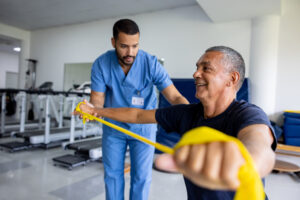“Sports injury” consists of injuries typically associated with sports or physical activities; however, the injury can happen to anyone, not just athletes.
Sports injuries such as strains, sprains, fractures, or other injuries can occur due to accidents, overexertion, improper technique, or underlying health conditions. It is therefore important for everyone to take proper measures, warm up properly, use appropriate equipment, and seek medical attention when needed to prevent and address sports-related injuries effectively.
Sports injuries can be categorised broadly into two main types: acute injuries and chronic injuries.
- Acute injuriesAcute injuries can happen suddenly and typically result from a single traumatic incident or impact commonly observed during sports engagements characterised by abrupt motions, collisions, or falls.Examples of acute injuries include sprains, strains, fractures, dislocations, and contusions which often cause immediate sensations of pain, swelling, and restricted mobility. Addressing acute injuries promptly is important, necessitating immediate medical intervention ranging from initial aid and immobilisation to potential surgical procedures in severe cases.
- Chronic injuriesChronic injuries progress gradually and frequently arise from prolonged overuse or repeated strain on specific areas of the body. Individuals engaged in repetitive movements or intense physical activities over extended durations are prone to such injuries. Symptoms of chronic injuries include persistent discomfort, inflammation, and diminished functionality. Examples include tendinitis, stress fractures, bursitis, and ongoing muscle strains. Chronic injuries can be effectively managed through ample rest, tailored physical therapy, adjustments in activity levels, and targeting underlying factors such as biomechanical imbalances or errors in training regimes.
Understanding the differences between acute and chronic injuries is crucial for proper diagnosis, treatment, and prevention strategies in sports medicine and rehabilitation.
Who gets sports injuries?
Sports injuries can impact a diverse range of individuals including athletes, fitness enthusiasts, active individuals, workers in physically demanding occupations, children, adolescents, and older adults.
Anyone can suffer a sports injury; however, these risk factors increase your risk of sustaining injury:
- Inadequate physical conditioning: The lack of levels of physical fitness or conditioning heightens the risk of injury, as weak muscles, ligaments, and tendons may not offer enough support during physical activity.
- Repetitive stress: Continuous strain on the same muscles and joints without adequate rest can result in overuse injuries such as tendinitis, stress fractures, and muscle strains.
- Incorrect techniques: Utilising improper form or technique during sports or exercises can excessively strain specific body parts, increasing the chances of injury.
- Lack of warm-up and stretching: Skipping warm-up routines or inadequate stretching before physical activity can decrease flexibility and raise the risk of muscle strains, tears, and other injuries.
- Environmental Influence: Factors like extreme temperatures, subpar playing surfaces, or inadequate equipment can contribute to the risk of sports-related injuries.
- Fatigue and Excessive Training: Pushing the body beyond its limits or insufficiently allowing for rest between training sessions can lead to fatigue and overtraining, heightening injury risk.
- Biomedical conditions: Structural irregularities, muscle imbalances, or wrong body mechanics can increase the risk of injuries during physical activity.
- Age and Growth Stage: Children and adolescents undergoing growth spurts may face an increased risk of certain injuries due to changes in bone, muscle, and joint development.
Who can benefit from sports physiotherapy?
- Athletes: Physiotherapists collaborate closely with athletes, offering personalised training programs, addressing biomechanical issues, and overseeing injuries to optimise their performance.
- Recreational fitness enthusiasts: Physiotherapists can help prevent injuries, elevate fitness levels and improve performance. They provide customised advice regarding warm-up protocols, exercise methodologies, and injury prevention tactics tailored to each person’s specific goals and needs.
- Individuals with chronic conditions: Sports physiotherapy is beneficial for those with chronic musculoskeletal conditions like arthritis, fibromyalgia, or chronic back pain. Physiotherapists create personalised exercise programs, offer pain alleviation methods, and offer insights on self-management strategies to improve movement, functionality, and overall wellbeing.
- Workers with occupational injuries: People employed in physically demanding jobs such as construction workers or manual labourers, are at risk of work-related injuries or musculoskeletal issues. Sports physiotherapy can help in their recovery from injuries, improve ergonomic practices, and offer tactics that help prevent workplace injuries.
- Seniors: Older adults can find sports physiotherapy beneficial for preserving mobility, autonomy, and overall functional wellbeing as they grow older. Physiotherapists can offer customised exercise regimes, measures to prevent falls, and treatments to address age-related ailments like osteoarthritis or osteoporosis enabling seniors to maintain their involvement in daily activities.
What are the benefits of physiotherapy for sports injuries?
Physiotherapy plays an important role in helping an individual recover and eventually return to work. The rehabilitation process is heavily reliant on these interventions for athletes recuperating from sports injuries.
The benefits include:
- Pain relief: Physiotherapy techniques such as manual therapy, exercises and modalities like heat or cold therapy help alleviate pain associated with injuries or chronic conditions.
- Improved mobility and range of motion: Physiotherapy interventions target flexibility, joint mobility, and muscle strength, enhancing overall movement and range of motion, which is important for daily activities and sports performance.
- Rehabilitation and recovery: Physiotherapy assesses movement patterns, biomechanics, and muscle imbalances to develop personalised exercise programs aimed at preventing injuries and improving overall physical health and performance.
- Enhanced quality of life: Physiotherapy helps individuals regain independence, improve functional abilities, and manage pain, contributing to a better overall quality of life and well-being.
Sports physiotherapy for everyone
Sports physiotherapy is beneficial for various individuals, not just athletes. Whether you are an athlete looking to prevent injuries and optimise performance, or a senior seeking to maintain independence and functional wellbeing, sports physiotherapy offers personalised interventions to address your unique needs.
Get in touch with your friendly and experienced physiotherapist, Peter Ho / Pooja Solanki today!







